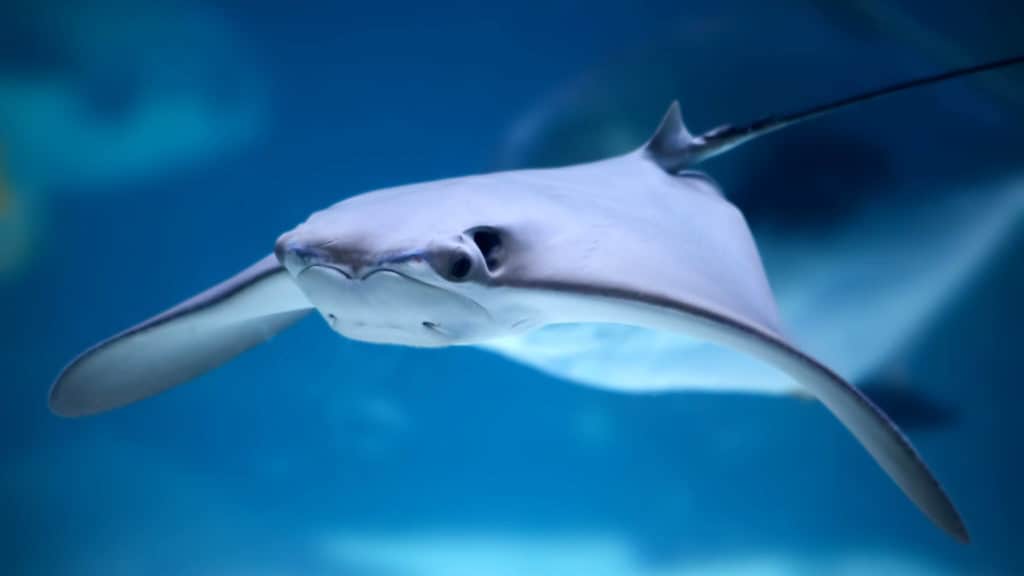Stingrays can be found in many of the world’s oceans, but are most common in coastal tropical and subtropical waters.
They spend most of their time inactive, buried in the sand, and often only move with the sway of the tide.
In this post, we’re going to take a look at stingray migration, and answer a question many of our readers ask. Do stingrays migrate?
Yes, stingrays take part in an annual migration that can include as many as 10,000 stingrays. They migrate to warmer waters by following the clockwise current from Mexico’s Yucatan Peninsula to Florida’s West Coast.
Where Do Stingrays Migrate To?
Golden cow-nose stingrays migrate only twice a year, traveling north in the late spring and then south in late autumn.
They migrate in huge numbers often up to 10,000 strong, which makes for an incredible aerial view or on-the-water experience.
They migrate between Western Florida and Yucatan in Mexico, heading to Western Florida in late spring and then southwest to Mexico and the Caribbean in the fall.
Cow-nose stingrays are found in the eastern Atlantic, near north-west Africa as well as in the western Atlantic from southern New England to northern Florida and throughout the Gulf of Mexico.
They have been known to migrate as far as the waters surrounding Trinidad, Brazil, and Venezuela.
How Often Do Stingrays Migrate?
Stingrays make a twice-a-year migration that scientists believe is triggered by changes in water temperature and sun orientation.
Cow-nose stingrays migrate once north in late spring to the warmer waters of Florida, then six months later make the journey south back down.
Why Do Stingrays Migrate?
Like many marine animals, one of the main reasons stingrays migrate is to reach more abundant summer feeding grounds.
Stingrays are opportunistic feeders that feed on whatever is available. They usually eat softshell clams, crabs, oysters, and more.
Cow-nose stingrays are unlike the more than 70 other stingray species as they prefer to stay on the move than stay buried in the sand.
However, they do still have a barb that is more than capable of defending them from sharks and other predators that may attack a migrating stingray.
Another reason for the stingray’s migration is that they much prefer warmer waters, which makes sense for them to migrate in the summer up to Florida.
When Do Stingrays Migrate?
Stingrays migrate only twice yearly by following the clockwise current from Mexico up to western Florida.
They make the migration northwards to Florida in late spring, usually between the months of April – May, and then come back down to Mexico between the months of October – November.
This allows them to make the most of the warm waters in Florida as well as the abundant feeding grounds.
More On Stingray Migration
The stingray migration is a spectacle that is incredible to witness, often with over 10,000 stingrays swimming at one time, it can be a once-in-a-lifetime opportunity that can take your breath away.
Some lucky people who have witnessed the stingray migration have described the event as being like “a shower of golden leaves glistening in the ocean, appearing one minute and then gone the next”.
Cow-nose stingrays are incredibly strong swimmers and prefer to stay on the move in search of food rather than buried in the sand.
Check out this amazing video of the stingray migration to get a better understanding of this natural spectacle:
Although stingrays are much more timid and gentle creatures than many think, you would not want to find yourself in the middle of a stingray migration.
These rays, like many other stingrays, do have a barb that is venomous, even though a sting would be incredibly painful, thankfully the venom is usually not deadly for humans.
Final Thoughts
So, do stingrays migrate? Yes, they certainly do. Stingrays make a migration twice yearly in order to reach warmer waters and more fruitful feeding grounds.
They swim in incredibly large groups, sometimes up to 10,000 strong. This allows them to have safety in numbers and gives them the best chance of survival during migration.
The migrations can sometimes be up to 930 miles, so these rays need to be strong swimmers in order to complete this long journey.
Scientists believe that the migration may be triggered by seasonal changes in water temperature, prompting the rays to migrate to warmer waters.
Nature is incredible, and it’s amazing that these animals instinctively know where to go in order to reach warmer tropical waters.
Hopefully, this post has been helpful and you’ve learned something new today about stingray migration.
Thanks for taking the time to read this post and feel free to stick around to learn more about stingrays and other marine life.

Hi, I’m George – the founder of MarinePatch. I created this blog as marine wildlife has been my passion for many years. I’ve spent over a decade in the marine wildlife industry and spent years out in the field conducting research. In today’s modern world, an online blog is the best place for me to share my findings and reach as many people as possible to help educate and inspire others. Enjoy your time here and you’re welcome back anytime!

